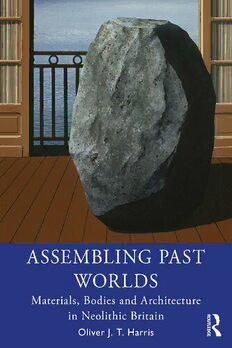
Assembling Past Worlds: Materials, Bodies and Architecture in Neolithic Britain PDF
Preview Assembling Past Worlds: Materials, Bodies and Architecture in Neolithic Britain
ASSEMBLING PAST WORLDS Assembling Past Worlds draws on new materialism and the philosophy of Gilles Deleuze to explore the potential for a posthumanist archaeology. Through specific empirical study, this book provides a detailed analysis of Neolithic Britain, a critical moment in the emergence of new ways of living, as well as new relationships between materials, people and new forms of architecture. It achieves two things. First, it identifies the major challenges that archaeology faces in the light of current theoretical shifts. New ideas place new demands on how we write and think about the past, sometimes in ways that can seem contradictory. This volume identifies seven major challenges that have emerged and sets out why they matter, why archaeology needs to engage with them and how they can be dealt with through an innovative theoretical approach. Second, it explores how this approach meets these challenges through an in-depth study of Neolithic Britain. It provides an insightful diagnosis of the issues posed by current archaeological thought and is the first volume to apply the philosophy of Gilles Deleuze to the extended analysis of a single period. Assembling Past Worlds shows how new approaches are transforming our understandings of past worlds and, in so doing, how we can meet the challenges facing archaeology today. It will be of interest to both students and researchers in archaeological theory and the Neolithic of Europe. Oliver J.T. Harris is Associate Professor of Archaeology at the University of Leicester. He is co-author of Archaeological Theory in the New Millennium (Routledge) and Archaeological Theory in Dialogue (Routledge). He researches new materialist, posthumanist and Deleuzian approaches to the past, applying them particularly, but not exclusively, to the Neolithic. He is co-director of the Ardnamurchan Transitions Project, which excavates sites across multiple periods on the west coast of Scotland. ASSEMBLING PAST WORLDS Materials, Bodies and Architecture in Neolithic Britain Oliver J.T. Harris First published 2021 by Routledge 2 Park Square, Milton Park, Abingdon, Oxon OX14 4RN and by Routledge 605 Third Avenue, New York, NY 10158 Routledge is an imprint of the Taylor & Francis Group, an informa business © 2021 Oliver J.T. Harris The right of Oliver J.T. Harris to be identified as author of this work has been asserted by him in accordance with sections 77 and 78 of the Copyright, Designs and Patents Act 1988. All rights reserved. No part of this book may be reprinted or reproduced or utilised in any form or by any electronic, mechanical, or other means, now known or hereafter invented, including photocopying and recording, or in any information storage or retrieval system, without permission in writing from the publishers. Trademark notice: Product or corporate names may be trademarks or registered trademarks, and are used only for identification and explanation without intent to infringe. British Library Cataloguing-in-Publication Data A catalogue record for this book is available from the British Library Library of Congress Cataloging-in-Publication Data Names: Harris, Oliver J. T., author. Title: Assembling past worlds : materials, bodies and architecture in neolithic Britain / Oliver J.T. Harris. Description: Abingdon, Oxon ; New York : Routledge, 2021. | Includes bibliographical references and index. Identifiers: LCCN 2020056433 (print) | LCCN 2020056434 (ebook) | ISBN 9780367414894 (hardback) | ISBN 9780367414917 (paperback) | ISBN 9780367814786 (ebook) Subjects: LCSH: Neolithic period—Great Britain. | Archaeology—Philosophy. Classification: LCC GN776.22.G7 H37 2021 (print) |LCC GN776.22.G7 (ebook) | DDC 936.1—dc23 LC record available at https://lccn.loc.gov/2020056433 LC ebook record available at https://lccn.loc.gov/2020056434 ISBN: 978-0-367-41489-4 (hbk) ISBN: 978-0-367-41491-7 (pbk) ISBN: 978-0-367-81478-6 (ebk) Typeset in Bembo by Apex CoVantage, LLC To Ellie, forever CONTENTS List of figures and tables ix Acknowledgements xi PART I Assembling a posthumanist archaeology 1 1 Assembling past worlds: an introduction 3 2 Seven challenges for a posthumanist archaeology 19 3 Fragments from philosophy 42 PART II Assembling Neolithic Britain 69 4 What were Neolithic materials capable of becoming? 71 5 What could a dead Neolithic body do? 111 6 What worlds did Neolithic architecture create? 155 viii Contents PART III Assembling past worlds 197 7 Time, history and memory: towards an ontography of the Neolithic 199 8 Conclusion 222 Glossary 236 References 242 Index 270 FIGURES AND TABLES Note: Representations of human remains appear as photographs in Figures 5.3 and 5.12, and as drawings in Figures 5.1, 5.2, 5.7, 5.8 and 5.10. Figures 1.1 A traditional comparison of difference between two cars 12 1.2 An Early Neolithic leaf-shaped arrowhead from Lincolnshire 14 1.3 Arthur’s Stone, Portal Dolmen, Gower Peninsula, Wales 15 2.1 Ontological elevation 25 3.1 A cat in the process of transforming a chair from virtual human seat to actual cat bed 53 3.2 Monument valley: a landscape differentiated by the action of long-gone oceans 57 4.1 Grooved Ware pottery from Martlesham 72 4.2 Map of sites discussed in the chapter 74 4.3 Lanyon Quoit, a Neolithic portal dolmen 77 4.4 Avebury 78 4.5 Flows of stone in the Avebury Landscape 80 4.6 Holm cursus monument 83 4.7 Plan of Warren Field timber hall 85 4.8 The Ring of Brodgar 87 4.9 Stonehenge 88 4.10 P37 (top) and P2 (lower) from Hambledon Hill 92 4.11 One of the flint scrapers from Grooved Ware pit 0004 from Martlesham 95 4.12 Polished stone axe from Cambridgeshire 102 4.13 Desire paths in (a) Leicester and (b) Wiltshire 105
